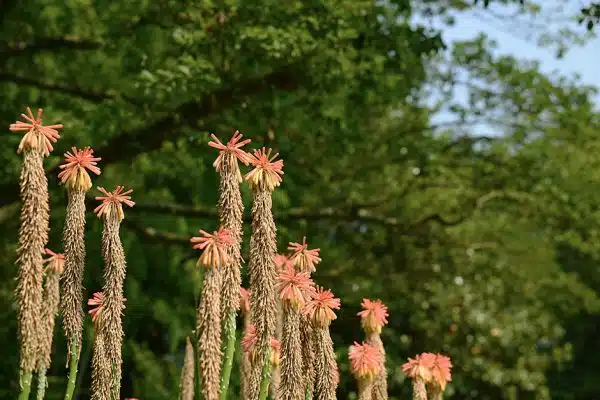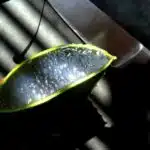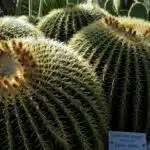Aloe arborescens, commonly known as Krantz Aloe, is a succulent plant that belongs to the family Asphodelaceae. This species of Aloe is native to South Africa and can grow up to 10 feet tall, making it an excellent choice for those who want to add some height to their garden. The plant’s green leaves are long and sword-shaped, with serrated edges that give it a unique appearance. Krantz Aloe has been used for centuries in traditional medicine due to its numerous health benefits.
If you are looking to grow Krantz Aloe in your garden, there are several factors that you need to consider. This article will provide you with all the information you need on how to cultivate this plant successfully. From soil requirements and watering needs to propagation techniques and pest control measures, we will cover everything you need to know about growing Krantz Aloe. Whether you are a seasoned gardener or a beginner looking to learn more about horticulture, this guide is perfect for anyone who wants to grow this beautiful succulent plant in their garden.
Overview Of Krantz Aloe
Krantz Aloe, also known as Aloe arborescens, is a succulent plant that is native to southern Africa. It is a member of the Asphodelaceae family and can grow up to 10 feet tall. Krantz Aloe has blue-green leaves that are arranged in rosettes and have serrated edges.
One of the benefits of Krantz Aloe is that it has medicinal properties. The gel inside the leaves can be used to treat burns, cuts, and other skin conditions. It can also help soothe inflammation and promote wound healing. Krantz Aloe is widely used in traditional medicine in southern Africa.
There are several varieties of Krantz Aloe, including the popular ‘Yellow’ variety which has yellow flowers and ‘Red’ variety which has red flowers. Each variety has its own unique characteristics and growing requirements. Understanding these differences is essential for successfully growing Krantz Aloe. In the following section, we will explore the history and traditional uses of Krantz Aloe in more detail.
History And Traditional Uses
Krantz aloe, also known as Aloe arborescens, is a succulent plant native to South Africa. This plant has been used for centuries in traditional practices for medicinal purposes. The gel from its leaves has been used to treat wounds, burns, and skin conditions such as eczema and psoriasis. Additionally, it has been used internally as a laxative and to boost the immune system.
The traditional uses of Krantz aloe have been backed up by modern scientific research which has confirmed its medicinal properties. Studies have shown that the gel from its leaves contains anti-inflammatory and antibacterial compounds that can help with wound healing and skin conditions. It has also been found to have potential anticancer properties due to the presence of certain compounds.
In addition to its medicinal properties, Krantz aloe is also an attractive plant that can be grown for decorative purposes. Its dense clusters of orange-red flowers make it an excellent choice for adding color to gardens or indoor spaces. With proper care, this plant can thrive in various soil types and climatic conditions. In the next section, we will discuss the soil requirements necessary for growing Krantz aloe successfully.
Soil Requirements
The soil is the foundation for any plant to grow and thrive. In the case of Krantz aloe, the soil quality can make or break its growth. To give your Krantz aloe the best chance at success, it is essential to choose the right type of soil. The best soil types for Krantz aloe are well-draining soils such as sandy loam or rocky soils.
When it comes to soil pH, Krantz aloe prefers slightly acidic to neutral soil with a pH range between 6.0 to 7.0. It is crucial to ensure that the soil pH level is maintained within this range for optimal growth and development. If the soil pH falls outside this range, it can lead to stunted growth and other issues.
To provide your Krantz aloe with adequate nutrients, add some organic matter such as compost or well-rotted manure into the planting hole before planting. Incorporating these materials will help improve soil fertility and promote healthy root development. Additionally, avoid using chemical fertilizers as they can harm beneficial microorganisms in the soil and cause more harm than good.
As you have learned about the best types of soils and their pH requirements for growing Krantz aloe successfully, let’s move on to discussing its watering needs. To ensure that your plant grows up healthy and robust, proper watering techniques are critical in maintaining ideal moisture levels in the soil.
Watering Needs
Watering Needs:
Proper watering is critical for the healthy growth of Krantz Aloe. This succulent plant requires moderate watering frequency, and overwatering can cause damage to its roots. It is essential to ensure that the soil is dry before adding water again. The best way to check if the soil is dry is by inserting your finger into it, up to a depth of one inch.
In addition to proper watering frequency, good drainage solutions are necessary for Krantz Aloe. Poor drainage can lead to waterlogging and root rot, which can be detrimental to the plant’s health. To avoid this, make sure that the pot has adequate drainage holes and that there is a layer of gravel or sand at the bottom of the pot. This will help to prevent water from accumulating at the bottom and promote better drainage.
Table:
| Watering Frequency | Drainage Solutions |
|---|---|
| Moderate | Adequate holes in pot |
| Layer of gravel or sand at bottom of pot |
Proper watering and drainage are crucial for maintaining Krantz Aloe’s health. When done correctly, this succulent plant can thrive and grow beautifully in any environment. In the next section, we will explore how lighting and temperature affect Krantz Aloe’s growth, which plays an equally important role in its overall well-being.
Lighting And Temperature
Watering is crucial for the growth and survival of Krantz aloe, as it is for any plant. However, watering needs vary depending on whether the plant is grown indoors or outdoors. If grown outdoors, the Krantz aloe requires little to no watering during rainy seasons, but during dry seasons, it should be watered more frequently. On the other hand, if you are growing your plant indoors, it will require less water than when grown outside due to lower levels of evaporation.
Apart from watering needs, lighting and temperature also play an important role in growing Krantz aloe. This plant prefers full sun exposure but may tolerate partial shade in hot climates. Indoors, place your Krantz aloe near a bright window that allows enough light to reach its leaves. The optimal temperature range for this plant is between 60-85°F (15-29°C), which makes it suitable for most households.
When growing Krantz aloe, it is essential to take into account seasonal variations. During winter months, the plant goes dormant and requires little watering and fertilization. However, during spring and summer when temperatures rise and days become longer, increase your watering frequency and fertilize every two weeks with a balanced fertilizer.
- Make sure to adjust your watering schedule based on whether your Krantz aloe is grown indoors or outdoors.
- Place your plant in an area that provides enough sunlight exposure.
- Keep the temperature within the optimal range of 60-85°F (15-29°C).
- Adjust your care routine according to seasonal variations.
Moving forward into propagation techniques section; propagating Krantz aloes can be done through several methods such as stem cuttings or division of offsets from mature plants.
Propagation Techniques
Propagation Techniques:
To continue the growth of Krantz Aloe, gardeners can choose from a variety of propagation techniques. Water propagation is one such method that involves placing cuttings in water until roots develop. This technique is ideal for those without access to rooting hormone or other specialized equipment. It’s important to note that while this method is easy and accessible, it may take longer for cuttings to develop roots compared to other methods.
Another popular technique used by horticulturists is division. This process involves separating the plant into smaller sections, each with its own root system. Gardeners should wait until the plant has grown large enough before attempting division techniques as the process can be stressful for the plant. In general, plants should be divided every few years to promote healthy growth and prevent overcrowding.
For those interested in learning more about propagation techniques for Krantz Aloe, below is a table outlining some key considerations:
| Technique | Advantages | Disadvantages |
|---|---|---|
| Water Propagation | Easy and accessible; no need for rooting hormone | May take longer for roots to develop |
| Division | Separates plant into smaller sections with their own root systems | Can be stressful for the plant if not done correctly |
Moving forward, gardeners who have successfully propagated Krantz Aloe through either water propagation or division techniques may want to consider transplanting their new plants into larger pots or outdoor garden spaces.
Transplanting
When transplanting krantz aloe (aloe arborescens), it is important to choose a pot that is slightly bigger than the existing root ball and has good drainage. The soil used should be a well-draining cacti and succulent mix, and it is beneficial to add a slow-release fertilizer to the soil. Prior to transplanting, the root ball should be gently loosened and any dead or damaged leaves should be removed. Finally, the plant should be placed in the pot at the same depth as it was previously growing.
Choosing A Pot
When it comes to transplanting a Krantz Aloe, choosing the right pot is crucial for its growth and survival. The pot size should be proportionate to the size of the plant, allowing enough space for roots to expand. It is recommended to choose a pot that is two inches wider than the diameter of the root ball. This will provide adequate room for the roots to spread and avoid overcrowding.
In addition to pot size, drainage needs are also important considerations when choosing a pot for your Krantz Aloe. The pot should have proper drainage holes to prevent water build-up, which can cause root rot and other fungal diseases. Adding a layer of gravel or small stones at the bottom of the pot can also help with drainage by creating air pockets and preventing soil compaction.
When selecting a pot, it is important to prioritize both size and drainage needs in order to provide an ideal environment for your Krantz Aloe’s growth. Properly transplanting your Krantz Aloe into a well-suited container will help ensure its overall health and longevity as it continues to thrive in its new home.
Preparing The Plant
Before transplanting a Krantz Aloe, it is important to prepare the plant for the process. One of the key steps in preparing the plant is selecting the appropriate potting mix. The ideal potting mix should be well-draining and nutrient-rich to support healthy growth. A good potting mix can be made by mixing equal parts of sand, perlite, and peat moss.
Another important aspect of preparing the plant for transplanting is choosing the right planting technique. When removing the Krantz Aloe from its current container, it is essential to handle the roots gently to avoid damaging them. It is also recommended to trim any damaged or dead roots before repotting. Once in its new container, ensure that soil is packed firmly around the base of the plant to provide stability.
In summary, preparing a Krantz Aloe for transplanting requires attention to detail and careful consideration. Selecting an appropriate potting mix and using a gentle planting technique are crucial factors that can help ensure successful transplantation and promote optimal growth for this beautiful succulent plant.
Fertilization
Fertilization is an essential aspect of Krantz Aloe (Aloe arborescens) growth. Organic and synthetic fertilizers are two common types of fertilizers that can be used to enhance soil fertility, promote healthy plant growth, and increase crop yields. Organic fertilizers are derived from natural sources such as compost, manure, and bone meal, while synthetic fertilizers are manufactured chemically.
Organic fertilizers are a preferred choice for many horticulturists because they improve soil structure and texture, reduce erosion, and help retain moisture in the soil. They also provide essential nutrients to plants at a slower rate than synthetic fertilizers, which means that there is less risk of over-fertilizing the plant. Furthermore, organic matter added to the soil through organic fertilizers improves microbial activity in the soil, leading to better nutrient uptake by plants.
Synthetic fertilizers contain specific ratios of essential nutrients such as nitrogen, phosphorus, and potassium (N-P-K), which are essential for plant growth. However, excessive use can lead to environmental pollution by contaminating groundwater with nitrates and other chemicals. Therefore, it is essential to follow the recommended application rates when using synthetic fertilizers on Krantz Aloe.
Moving forward into pruning and maintenance of Krantz Aloe (Aloe arborescens), it is important to consider some important aspects such as regular pruning of dead leaves or spent flowers. This process helps promote new growth while reducing pest infestation and disease incidence. Additionally, proper watering techniques such as avoiding waterlogging will ensure optimal plant health. These practices will ultimately lead to a healthier Krantz Aloe with better performance in terms of yield production and ornamental value.
Pruning And Maintenance
- When it comes to watering, Krantz Aloe (Aloe arborescens) should be watered deeply when soil has dried out.
- Fertilization should be done in late spring and early summer, with an all purpose, slow-release fertilizer.
- Pruning should be done at the end of the summer, focusing mainly on removing dead, damaged, or diseased foliage.
- Pruning also helps to maintain the desired shape of the plant, and should be done carefully to prevent removal of healthy growth.
- It is important to use clean, sharp pruning tools to prevent spread of disease when pruning Krantz Aloe.
- Regular pruning and maintenance of Krantz Aloe is essential to promoting healthy growth and good flowering.
Watering
Watering is an essential aspect of growing Krantz aloe. The frequency of watering varies depending on the environmental conditions and the plant’s growth stage. In general, it is recommended to water the plant every two weeks during the summer months and once a month during winter. However, it is crucial to keep an eye on the soil moisture level and adjust watering frequency accordingly.
One important technique in watering Krantz aloe is to avoid overwatering. Too much water can lead to root rot, which can be detrimental to the plant’s health. To prevent this, one should ensure that the soil is well-drained and not waterlogged. It is also advisable to water the plant in the morning or evening when temperatures are cooler to reduce evaporation.
Another effective technique for watering Krantz aloe is deep watering. This involves giving the plant a thorough soak rather than surface-level watering. Deep watering encourages deep root growth and helps establish a strong root system. One can achieve this by slowly pouring water around the base of the plant until it runs out from underneath. It is crucial to allow enough time between watering sessions for the soil to dry out slightly before repeating the process.
In conclusion, maintaining proper watering techniques is crucial for growing healthy Krantz aloes. Watering frequency should be adjusted based on environmental conditions and growth stage while avoiding overwatering by ensuring well-draining soil and deep watering techniques to promote healthy root growth.
Fertilizing
As horticulturists, we understand that pruning and maintenance are essential for the health of Krantz aloe plants. However, fertilizing is another crucial aspect that should not be overlooked. Proper fertilization can provide the necessary nutrients for growth and overall health. There are two types of fertilizers that can be used: organic and synthetic.
Organic fertilizers are derived from natural sources such as compost, manure, or bone meal. They release nutrients slowly over time and improve soil structure and fertility. On the other hand, synthetic fertilizers are chemically produced and provide an immediate nutrient boost to plants. However, they may also have negative environmental impacts if not used properly.
When fertilizing Krantz aloes, it is important to follow manufacturer instructions carefully and avoid over-fertilization. Overuse of synthetic fertilizers can lead to salt buildup in the soil, which can harm plant roots. Organic fertilizers may require more frequent applications but are generally safer for plants and the environment in the long run.
In conclusion, proper fertilization techniques play a critical role in maintaining healthy Krantz aloe plants. Horticulturists should carefully consider which type of fertilizer to use while following manufacturer instructions closely to avoid over-fertilization. By incorporating regular fertilization into their maintenance routine, they can ensure robust growth and vibrant foliage for these beautiful succulents.
Pruning
Pruning is an essential aspect of maintaining the health and appearance of Krantz aloe plants. The primary objective of pruning is to remove dead or damaged leaves, which can prevent the plant from producing new growth. Horticulturists should use sharp, clean tools, such as pruning shears or scissors, to avoid injuring the plant while cutting. It is also crucial to time pruning correctly to avoid disrupting the plant’s natural growth cycle.
Regular pruning can also help control the size and shape of Krantz aloes, making them suitable for various landscaping applications. Additionally, removing old flower spikes can promote new bloom development and prolong flowering periods. However, over-pruning can weaken the plant and make it more susceptible to disease and pest infestations.
Proper maintenance practices are critical for ensuring healthy Krantz aloe plants, and pruning is an integral part of this process. By using appropriate tools and timing cuts carefully, horticulturists can maintain optimal plant health while controlling size and shape. Regular pruning also promotes new growth and flowering while avoiding potential damage caused by over-pruning.
Common Pests And Diseases
After discussing the proper pruning and maintenance techniques for Krantz aloe, it is important to be aware of the common pests and diseases that can afflict this plant. These pests and diseases can cause significant damage to the health and appearance of the Krantz aloe, making it necessary to take preventative measures and utilize treatment options when necessary.
One of the most common pests that affect Krantz aloe is spider mites. These tiny arachnids feed on the plant’s sap, causing yellowing leaves and stunted growth. Another pest that can pose a threat is mealybugs, which are small white insects that feed on the sap as well. They can be identified by their fluffy white appearance, often covering leaves or stems. Scale insects are also a concern, as they secrete a sticky substance called honeydew that attracts ants and other insects.
In addition to these pests, Krantz aloe is also susceptible to fungal diseases such as root rot and leaf spot. Root rot occurs when soil remains waterlogged for extended periods of time, while leaf spot presents with dark spots on foliage. To prevent these issues from occurring, it is important to keep soil well-draining and avoid overwatering. Treatment options for pests may include insecticidal soap or neem oil sprays, while fungal diseases may require fungicides or removal of infected areas.
- Keep an eye out for signs of pest infestations or disease.
- Regularly inspect your Krantz aloe plants.
- Take preventative measures such as maintaining good drainage.
- Utilize natural remedies like neem oil sprays.
- Consider contacting a professional horticulturist if problems persist.
Moving forward into pest control measures, it is important to stay vigilant in monitoring Krantz aloes for any signs of issues. By taking preventative measures such as good drainage practices and utilizing natural remedies like neem oil sprays, you can help keep your plants healthy and thriving. However, if problems persist or become severe, it may be necessary to seek the assistance of a professional horticulturist to ensure that your Krantz aloes remain in top condition.
Pest Control Measures
Pest Control Measures:
Krantz aloe is a hardy plant that is resistant to most pests and diseases. However, like any other plant, it can be susceptible to infestation if not properly cared for. Prevention is always better than cure when it comes to pest control, and the best way to keep your Krantz aloe healthy is by providing it with sufficient sunlight, water, and nutrients.
Natural remedies are the best way to control pests on your Krantz aloe. Insects like aphids and spider mites can be controlled using natural methods like spraying with neem oil or applying garlic spray. These natural remedies are safe for both the plant and the environment. Chemical solutions should only be used as a last resort, as they can harm beneficial insects and may also have adverse effects on human health.
If you do need to use chemical solutions to control pests on your Krantz aloe, make sure you follow all safety instructions carefully. Wear gloves and protective clothing when handling chemicals, and never apply them in windy conditions. Always make sure you choose the right product for the type of pest you are dealing with. Remember that chemical pesticides should only be used as a last resort after all other options have been exhausted.
In summary, keeping your Krantz aloe healthy by providing it with optimal growing conditions is the best way to prevent pest infestation. Natural remedies are effective in controlling pests without harming beneficial insects or posing risks to human health. In case of severe infestation where natural methods have failed, chemical solutions should only be used as a last resort while following safety instructions carefully. In the next section, we will discuss harvesting and uses of Krantz aloe.
Harvesting And Uses
Pest control measures are essential for the optimal growth of Krantz Aloe, but it is equally crucial to understand how to harvest and use this plant. Aloe Arborescens, commonly known as Krantz Aloe, is a succulent plant species that belongs to the family Asphodelaceae. It is native to Southern Africa and grows well in warm and dry climates.
When harvesting Krantz Aloe, it is recommended to cut mature leaves from the bottom of the plant. The gel or sap obtained from these leaves is useful in treating skin conditions such as burns, rashes, and wounds. Additionally, Krantz Aloe can be used in various recipes and DIY skincare products due to its moisturizing properties.
If you plan on growing Krantz Aloe, here are four things you should keep in mind:
- Soil: Ensure that you plant your Krantz Aloe in well-draining soil with a pH range of 7-8.
- Watering: This plant requires moderate watering; avoid overwatering as it may cause root rot.
- Sunlight: Krantz Aloe thrives in full sun but can also grow well in partial shade.
- Fertilizer: Use a balanced fertilizer during the growing season (spring-summer) for optimal growth.
Other aloe varieties to consider include Aloe Vera, which has similar medicinal properties as Krantz Aloe but prefers more frequent watering than its cousin. Additionally, there is the Madagascar Dragon Tree (Dracaena marginata), which resembles an aloe plant but requires less light and water than most other species within this genus.
Other Aloe Varieties To Consider
Comparing Aloe Varieties is crucial for any gardener or horticulturist to ensure a diverse collection. While Krantz Aloe (Aloe arborescens) is an excellent choice, there are other varieties of aloe worth considering. One such variety is the Aloe vera plant, which is commonly used for medicinal purposes due to its gel-like substance that can help soothe skin irritations and burns.
Another option to consider is the Aloe ferox plant, also known as Cape Aloe. This variety produces tall spikes of yellow flowers and has thicker leaves than other aloe plants, making it more resilient to drought conditions. Additionally, it contains high levels of aloin, which is known for its laxative properties and has been used in traditional medicine.
Benefits of Diversifying Your Aloe Collection go beyond just having different types of plants in your garden. By growing a variety of aloe plants, you can experience their unique features and benefits firsthand. Furthermore, if one type of plant experiences disease or pest infestation, you will still have other healthy plants in your collection. It’s also important to note that many species of aloe are endangered due to over-harvesting for medicinal purposes; therefore, cultivating different varieties can help preserve these valuable plants.
Moving forward with your aloe collection, it’s essential to research each specific type before planting and understand their individual needs regarding soil type, water requirements, and sunlight exposure. In the subsequent section about tips for successful cultivation, we’ll delve deeper into the necessary steps required to grow healthy and thriving aloe plants.
Tips For Successful Cultivation
Growing Krantz Aloe requires patience, care, and attention. To ensure that your plant thrives, it is crucial to follow some tips for successful cultivation. Whether you’re interested in container gardening or outdoor landscaping, these guidelines will help you achieve beautiful results.
Firstly, consider the soil quality. Krantz Aloe prefers well-draining soil that is rich in nutrients. You can create a suitable mix by combining sand, perlite or vermiculite and potting soil in equal proportions. In addition, it is important to water the plant only when the soil is completely dry as it can easily rot when overwatered.
Secondly, Krantz Aloe needs plenty of sunlight to grow properly. When planting outdoors, choose a location with full sun exposure and good air circulation. If you are planning on container gardening, place your pot near a window where it can get at least six hours of direct sunlight each day.
By following these simple yet effective tips for growing Krantz Aloe, you will be able to enjoy its beauty and benefits for years to come. However, if you encounter any difficulties along the way or have questions about caring for your plant, refer to our frequently asked questions (FAQs) section below for additional guidance and support.
Frequently Asked Questions (Faqs
Common misconceptions about growing Krantz Aloe are abundant, and it is important to dispel them to ensure the best possible growth of this plant. One such misconception revolves around watering. It is often assumed that Krantz Aloe needs frequent watering, but this can lead to root rot and other issues. In reality, it is best to water this plant deeply but infrequently, allowing the soil to dry out between watering sessions.
Another common misconception surrounds the amount of sunlight Krantz Aloe requires. While it is true that this plant prefers bright and direct sunlight, too much exposure can scorch its leaves. It is important to provide some shade during hot summer months or in areas with intense sunlight. Indoor growers should ensure their plants receive plenty of natural light or supplement with high-quality grow lights.
The benefits of growing Krantz Aloe extend beyond just the aesthetic appeal of its striking foliage and vibrant flowers. This plant has a range of medicinal properties and has long been used in traditional medicine for its antibacterial, antiviral, and anti-inflammatory properties. Additionally, Krantz Aloe helps purify the air in your home by removing toxins like formaldehyde and benzene from the surrounding environment.
In summary, growing Krantz Aloe requires careful attention paid to watering frequency and exposure to sunlight. Common misconceptions surrounding these aspects can lead to stunted growth or even death of the plant. However, the benefits of growing this beautiful succulent extend beyond just visual appeal into a range of medicinal properties as well as air purification abilities.
Conclusion
Krantz Aloe, also known as Aloe arborescens, is a highly sought-after plant for its aesthetic appeal and medicinal properties. This article provided an overview of the Krantz Aloe plant, including its history and traditional uses. It also delved into the soil requirements, watering needs, lighting and temperature preferences of the plant.
Harvesting and uses of Krantz Aloe were explored in detail, highlighting its many health benefits such as aiding digestion and boosting immunity. Other notable aloe varieties were mentioned for those interested in exploring different options.
Tips for successful cultivation of Krantz Aloe were provided to ensure that growers can reap the maximum benefits from their plants. Finally, frequently asked questions were addressed to provide further clarity on the topic.
While some may argue that growing Krantz Aloe is time-consuming and requires specialized care, with proper attention to its needs, it can be a rewarding experience both aesthetically and medicinally. As horticulturists know all too well, any plant requires patience and effort for successful growth – but the benefits outweigh the challenges. With this comprehensive guide at hand, cultivating Krantz Aloe could not be easier or more rewarding.
Image Credits
- “Krantz Aloe キダチアロエ” by Nyon-Nyon (featured)





























